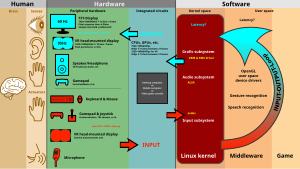Peripheral
This article needs additional citations for verification. (May 2016) |

A peripheral or peripheral device is "an ancillary device used to put information into and get information out of the computer".[1]
Three categories of peripheral devices exist based on their relationship with the computer:
- an input device sends data or instructions to the computer, such as a mouse, keyboard, graphics tablet, image scanner, barcode reader, game controller, light pen, light gun, microphone, digital camera, webcam, dance pad, and read-only memory);
- an output device provides output from the computer, such as a computer monitor, projector, printer, headphones and computer speaker); and
- an input/output device performs both input and output functions, such as a computer data storage device (including a disk drive, USB flash drive, memory card and tape drive).
Many modern electronic devices, such as internet capable digital watches, keyboards, and tablet computers, have interfaces that allow them to be used as computer peripheral devices.
See also
Look up peripheral in Wiktionary, the free dictionary.
- Computer hardware
- Controller (computing)
- Display device
- Expansion card
- Punched card input/output
- Punched tape
- Video game accessory
References
- ^ Laplante, Philip A. (2000). Dictionary of Computer Science, Engineering and Technology. CRC Press. p. 366. ISBN 0-8493-2691-5. Archived from the original on September 23, 2016. Retrieved January 16, 2018.
{{cite book}}:|archive-date=/|archive-url=timestamp mismatch; September 3, 2016 suggested (help)

